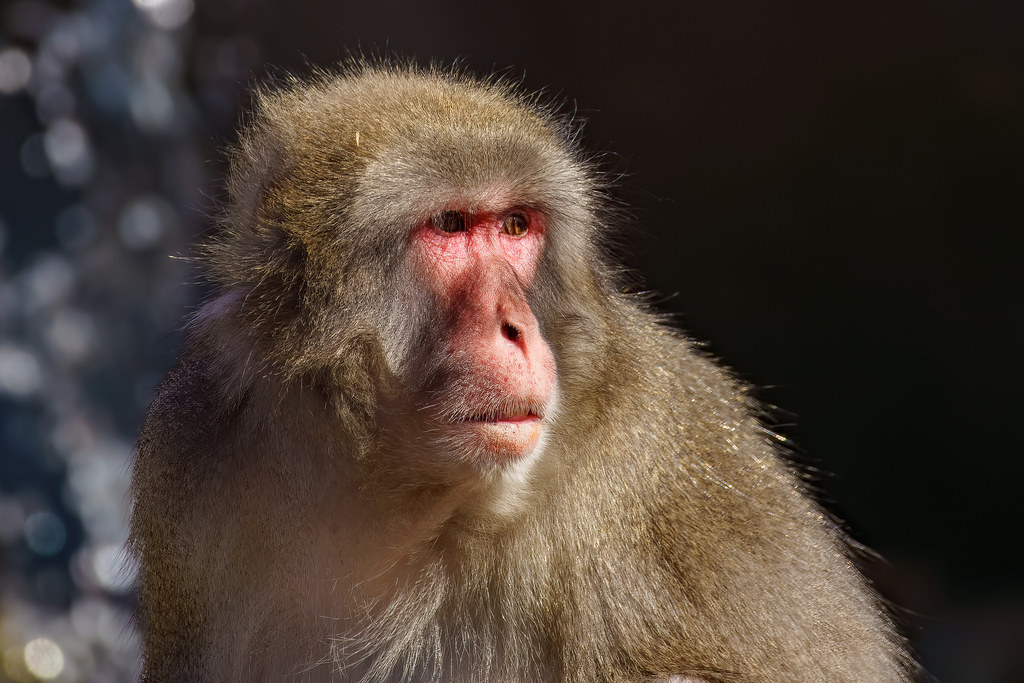#Macaca fuscata
Text
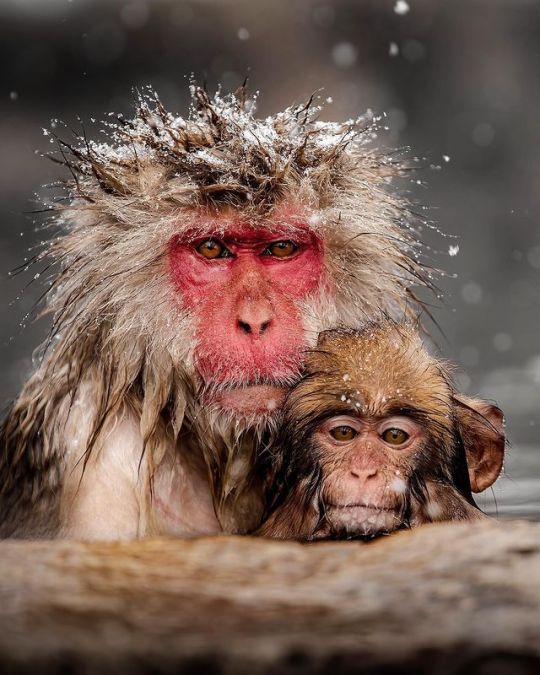
Japanese Macaque
#japanese macaque#macaque#snow monkey#monkey#Macaca fuscata#Primates#Haplorhini#Simiiformes#Cercopithecidae#Macaca#upl
39 notes
·
View notes
Text



背景が白くて雪原みたいになった!
@豊橋動植物公園
The white background made it look like a photo taken snow monkies in a snowfield.
@Toyohashi Zoo & Botanical Park
24 notes
·
View notes
Text

Japanese macaques (Macaca fuscata) relax in Jigokudani Hot Spring, Nagano, Japan
by Sean Crane
#japanese macaque#macaques#monkeys#macaca fuscata#macaca#Cercopithecidae#Simiiformes#haplorhini#primates#mammalia#chordata#wildlife: japan#wildlife: asia
42 notes
·
View notes
Text
Happy Wet Beast Wednesday!

9 notes
·
View notes
Text
Masturbation is also common in both males and females.
"Biological Exuberance: Animal Homosexuality and Natural Diversity" - Bruce Bagemihl
0 notes
Text
In some troops, all females that participate in same-sex consortships are bisexual, also consorting with males; however, while paired with a female they remain faithful to their partner, ignoring or rebuffing any advances made by males toward them. In other troops, though, some females are exclusively lesbian, engaging in sexual interactions only with females: in these cases, an average of 9 percent of females are homosexual, 56 percent bisexual, and 35 percent exclusively heterosexual.
"Biological Exuberance: Animal Homosexuality and Natural Diversity" - Bruce Bagemihl
#book quote#biological exuberance#bruce bagemihl#nonfiction#japanese macaque#macaca fuscata#consortship#bisexual#faithful#monogamy#lesbian#homosexual#heterosexual
1 note
·
View note
Text
Japanese Macaques live in cosexual troops of 20-100 individuals, subdivided into smaller matrilineal groups composed of numerous related females and several unrelated males.
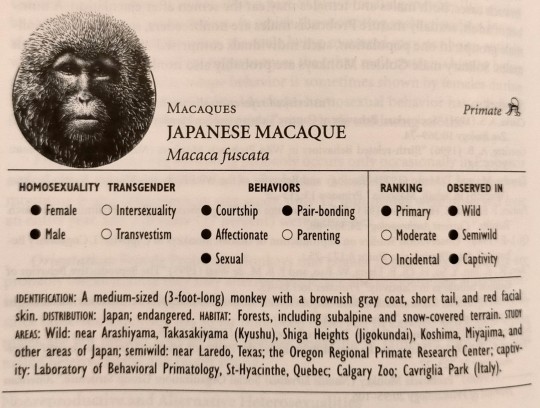
"Biological Exuberance: Animal Homosexuality and Natural Diversity" - Bruce Bagemihl
#book quotes#biological exuberance#bruce bagemihl#nonfiction#japanese macaque#macaca fuscata#matrilineal
0 notes
Text

#snow monkey#Japanese macaque#primates#mammalia#mammal#primate#my art#art#macaca#macaca fuscata#cercopithecidae#cercopithecid#steam#hot spring#monkey
1 note
·
View note
Video
Japanse Makaak_02 by Nick Dijkstra
#Amsterdam#Artis#Japanese macaque#Japanmakak#Japanse Makaak#Macaca fuscata#Mamal#Zoo#Zoogdier#flickr
1 note
·
View note
Text

Japanese Macaque aka Japanese Snow Monkey (Macaca fuscata), mother with babe, family Cercopithecidae, Japan
photograph by nobody235monkeys | IG
83 notes
·
View notes
Text
Animal of the Day!
Japanese Macaque (Macaca fuscata)

(Photo from iStock)
Conservation Status- Least Concern
Habitat- Japan excluding Hokkaido
Size (Weight/Length)- 11 kg; 82 cm
Diet- Leaves; Seeds; Fruits; Small mammals
Cool Facts- The Japanese macaque might be the most northern living primate, but their winters are spent living like kings. Living in female-run societies, Japanese macaques pass down their status to their offspring. Spending their days grooming, chatting, and babysitting, these primates spend the majority of their lives on the ground outside of feeding. During harsh winters, Japanese macaques form mega groups around hot springs. The macaques rarely leave the warm water and only do so to grab a quick snack. Younger macaques have been seen rolling snowballs and playing in snow.
Rating- 11/10 (Snow monkeys.)
#Animal of the day#Animals#Monkey#Primate#Macaque#Monday#January 23#Japanese macaque#Snow monkey#biology#science#conservation#the more you know
184 notes
·
View notes
Text

Japanese macaque (Macaca fuscata)
Beaten only by humans for the title of the furthest-north primate, this monkey lives in a huge range of climates on the islands of Japan, including snowy and mountainous regions. They are famous for their habit of spending time in hot springs to escape the cold. They are also rather intelligent, one group of macaques inventing the idea to wash their food before consumption. They eat a variety of foods, including leaves, fruits, bark, roots, insects, fish, soil, and fungus. Finally, the Japanese macaque is another species of monkey in which homosexuality has been documented; it has even been proposed that most female members of this species are bisexual!
#markhors-menagerie#primates#old world monkeys#monkeys#animal facts#fun facts#animals#biology#macaque#Japanese macaque
40 notes
·
View notes
Text
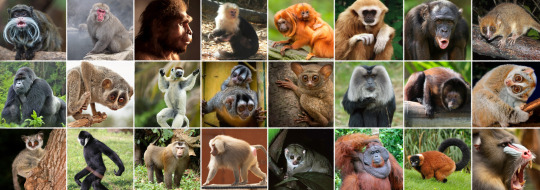
🦍The primate tournament list of candidates has been finalised! Polls will start going up soon!🦧
Thank you to everyone who submitted a species! Here is the full written list:
Basal primates (non-simian primates, including Strepsirrhini and Tarsiiformes)
†Notharctus (Notharctus tenebrosus)
Calabar angwantibo (Arctocebus calabarensis)
West African potto (Perodicticus potto)
Red slender loris (Loris tardigradus)
Bengal slow loris (Nycticebus bengalensis)
Pygmy slow loris (Xanthonycticebus pygmaeus)
Senegal bushbaby (Galago senegalensis)
Brown greater galago (Otolemur crassicaudatus)
Ring-tailed lemur (Lemur catta)
Verreaux’s sifaka (Propithecus verreauxi)
†Archaeoindris (Archaeoindris fontoynontii)
†Megaladapis (Megaladapis madagascariensis)
Madame berthe’s mouse lemur (Microcebus berthae)
Aye-aye (Daubentonia madagascariensis)
Philippine tarsier (Carlito syrichta)
Pygmy tarsier (Tarsius pumilus)
New world monkeys (Platyrrhini)
Wied’s marmoset (Callithrix kuhlii)
Goeldi’s marmoset (Callimico goeldii)
Bearded emperor tamarin (Saguinus imperator subgrisescens)
Golden-headed lion tamarin (Leontopithecus chrysomelas)
Panamanian white-faced capuchin (Cebus imitator)
Central American squirrel monkey (Saimiri oerstedii)
Gray-bellied night monkey (Aotus lemurinus)
Bald uakari (Cacajao calvus)
Madidi titi monkey (Plecturocebus aureipalatii)
Atlantic titi monkey (Callicebus personatus)
Black bearded saki (Chiropotes satanas)
White-faced saki (Pithecia pithecia)
Colombian red howler (Alouatta seniculus)
Brown spider monkey (Ateles hybridus)
Northern muriqui (Brachyteles hypoxanthus)
Yellow-tailed woolly monkey (Lagothrix flavicauda)
Old world monkeys (Cercopithecidae)
Mantled guereza (Colobus guereza)
Zanzibar red colobus (Piliocolobus kirkii)
Nepal gray langur (Semnopithecus schistaceus)
Silvery lutung (Trachypithecus cristatux)
Golden snub-nosed monkey (Rhinopithecus roxellana)
Proboscis monkey (Nasalis larvatus)
Red-shanked douc (Pygathrix nemaeus)
Collared mangabey (Cercocebus torquatus)
Japanese macaque (Macaca fuscata)
Rhesus macaque (Macaca mulatta)
Hamadryas baboon (Papio hamadryas)
Mandrill (Mandrillus sphinx)
Gelada (Theropithecus gelada)
Common patas monkey (Erythrocebus patas)
Bale mountains vervet (Chlorocebus djamdjamensis)
De brazza’s monkey (Cercopithecus neglectus)
Apes (Hominoidea)
Lar gibbon (Hylobates lar)
Pileated gibbon (Hylobates pileatus)
Kloss’s gibbon (Hylobates klossii)
Northern white-cheeked gibbon (Nomascus leucogenys)
Siamang (symphalangus syndactylus)
†Junzi (Junzi imperialis)
Bornean orangutan (Pongo pygmaeus)
†Gigantopithecus (Gigantopithecus blacki)
†Dryopithecus (Dryopithecus fontani)
Western lowland gorilla (Gorilla gorilla gorilla)
Chimpanzee (Pan troglodytes)
Bonobo (Pan paniscus)
†Australopithecus (Australopithecus afarensis)
†Panranthropus (Panranthropus boisei)
†Flores hobbit (Homo floresiensis)
†Neanderthal (Homo neanderthalensis)

The first set of polls will go up as soon as I have finished writing the descriptions! In the meantime, I would appreciate if you could share this tournament around- it won’t be much of a tournament if there aren’t that many people voting! In going down the research rabbit hole I’ve found so many interesting species and stories, and I promise learning about them here will be worth your time!
#primate bracket#tournament#tumblr tournament#poll#polls#primate#primates#extinct primates#biology#animals#zoology#please let me know if I made a mistake anywhere!
97 notes
·
View notes
Photo

A mother Japanese macaque (Macaca fuscata) with a baby on her back. 子を背負うニホンザル母
#nature#animal#macaque#june#summer#niigata#japan#original photographers#photographers on tumblr#xr rikenon 50mm/f2
22 notes
·
View notes
Text
食物を取りこぼさないようにする��ニホンザルにおける採食経路の選択
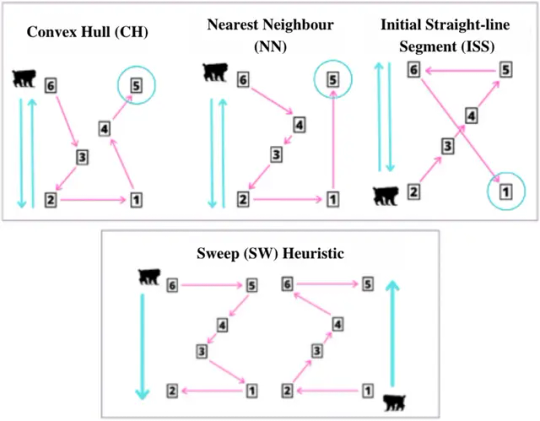
淡路島でこんな研究もやっています!
Joyce, M. M., Teichroeb, J. A., Kaigaishi, Y., Stewart, B. M., Yamada, K., & Turner, S. E. (2023). No food left behind: foraging route choices among free-ranging Japanese macaques (Macaca fuscata) in a multi-destination array at the Awajishima Monkey Center, Japan [Article]. Primates, 64(5), 495-511. https://doi.org/10.1007/s10329-023-01070-z
食物を取りこぼさないようにする:淡路島モンキーセンターの餌付けニホンザルにおける採食経路の選択
動物が採食中に移動する際には、経路の選択が求められる。最適採食理論は最適な経路を予測するが、霊長類では常に最短経路が選択されるわけではない。意思決定にかかる認知的および時間的コストを削減するために、ヒューリスティック(経験則に基づく直感的な判断)を利用することが示されてきた。本研究では、淡路島モンキーセンターの餌付けニホンザル29頭を対象に、155回の野外実験を実施して、採食中に選択される経路を分析した。Zの形に設置した6つの台に餌を置いて、対象個体の採食経路を調べることで、どのようなヒューリスティックを利用しているか、個体の年齢、性別、社会的要因(群れの中心個体か周辺個体か、異種または同種の競合他者が近くにいたかどうか)がヒューリスティックの利用、移動距離、試行時間に与える影響を検討した。
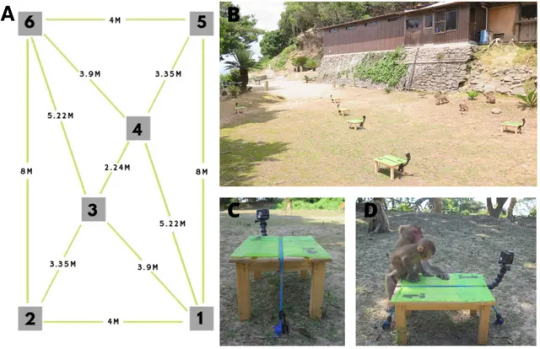
720種類の経路が利用可能な中で、対象個体のニホンザルは偶然よりも高い確率で特定の経路を選択していた。最短経路が最も頻繁に選択されており(23.9%)、続いて、最近傍ヒューリスティック(19.4%:すべての採食地点を利用し終えるまで、現在地から次に近い地点へ連続的に移動し続ける)と凸包ヒューリスティック(4.5%:外側の採食地点を連続して回りながら、端に近い内側の採食地点を訪れる)が選択されていた。また、新たなヒューリスティックとして「スイープ・ヒューリスティック」が頻繁に利用されていた。これは一方向に向けて餌を拾いながら移動することで、残りの餌を全て視野に入れて、他個体からの横取りを警戒するものであった。未成体は成体や準成体よりも試行時間が短く、資源へのアクセスを高めるために移動スピードを速める戦術を採用していた。同種他個体が近くにいる場合には、移動距離が有意に長くなった。これらの結果は、ニホンザルの経路選択には個体の年齢が影響していること、そして「スイープ・ヒューリスティック」は移動距離が長くなるものの、同種他個体との採食競合に対する反応であった可能性を示唆している。(文責:山田一憲)
0 notes
Text
Unlike heterosexual and lesbian interactions, most mounts between males are single (rather than series) and are generally briefer, although they can still invoice full erections, pelvic thrusting, penetration, and/or ejaculation.
"Biological Exuberance: Animal Homosexuality and Natural Diversity" - Bruce Bagemihl
#book quote#biological exuberance#bruce bagemihl#nonfiction#heterosexual#lesbian#gay#mounting#japanese macaque#macaca fuscata
0 notes
